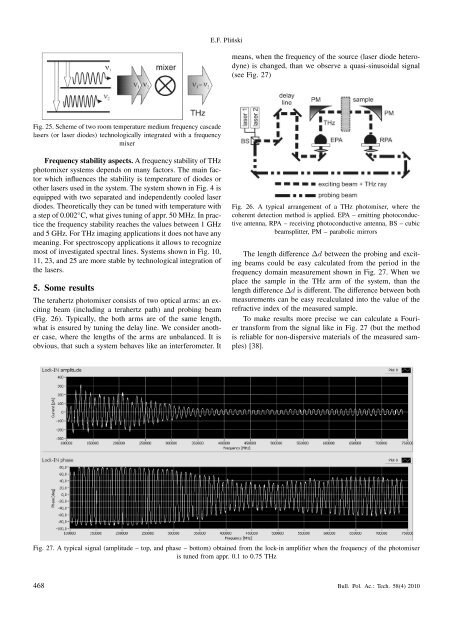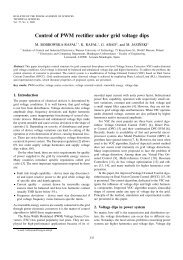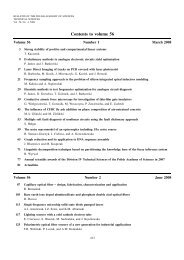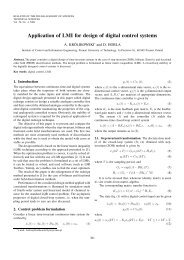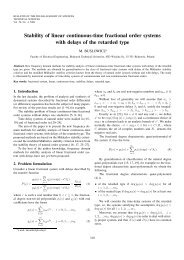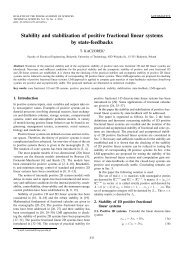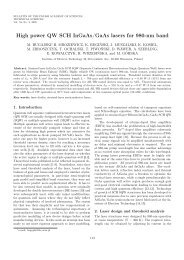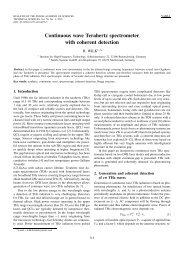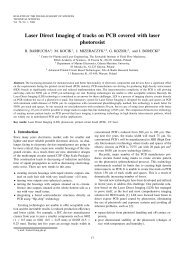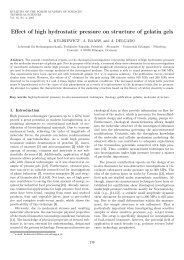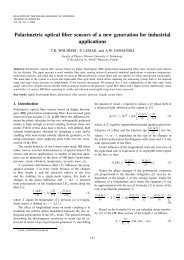Fig. 25. Scheme <strong>of</strong> two room temperature medium frequency cascade lasers (or laser diodes) technologically integrated with a frequency mixer Frequency stability aspects. A frequency stability <strong>of</strong> THz photomixer systems depends on many factors. The main factor which influences <strong>the</strong> stability is temperature <strong>of</strong> diodes or o<strong>the</strong>r lasers used in <strong>the</strong> system. The system shown in Fig. 4 is equipped with two separated and independently cooled laser diodes. Theoretically <strong>the</strong>y can be tuned with temperature with a step <strong>of</strong> 0.002 ◦ C, what gives tuning <strong>of</strong> appr. 50 MHz. In practice <strong>the</strong> frequency stability reaches <strong>the</strong> values between 1 GHz and 5 GHz. For THz imaging applications it does not have any meaning. For spectroscopy applications it allows to recognize most <strong>of</strong> investigated spectral lines. Systems shown in Fig. 10, 11, 23, and 25 are more stable by technological integration <strong>of</strong> <strong>the</strong> lasers. 5. Some results The terahertz photomixer consists <strong>of</strong> two optical arms: an exciting beam (including a terahertz path) and probing beam (Fig. 26). Typically, <strong>the</strong> both arms are <strong>of</strong> <strong>the</strong> same length, what is ensured by tuning <strong>the</strong> delay line. We consider ano<strong>the</strong>r case, where <strong>the</strong> lengths <strong>of</strong> <strong>the</strong> arms are unbalanced. It is obvious, that such a system behaves like an interferometer. It E.F. Pliński means, when <strong>the</strong> frequency <strong>of</strong> <strong>the</strong> source (laser diode heterodyne) is changed, than we observe a quasi-sinusoidal signal (see Fig. 27) Fig. 26. A typical arrangement <strong>of</strong> a THz photomixer, where <strong>the</strong> coherent detection method is applied. EPA – emitting photoconductive antenna, RPA – receiving photoconductive antenna, BS – cubic beamsplitter, PM – parabolic mirrors The length difference ∆d between <strong>the</strong> probing and exciting beams could be easy calculated from <strong>the</strong> period in <strong>the</strong> frequency domain measurement shown in Fig. 27. When we place <strong>the</strong> sample in <strong>the</strong> THz arm <strong>of</strong> <strong>the</strong> system, than <strong>the</strong> length difference ∆d is different. The difference between both measurements can be easy recalculated into <strong>the</strong> value <strong>of</strong> <strong>the</strong> refractive index <strong>of</strong> <strong>the</strong> measured sample. To make results more precise we can calculate a Fourier transform from <strong>the</strong> signal like in Fig. 27 (but <strong>the</strong> method is reliable for non-dispersive materials <strong>of</strong> <strong>the</strong> measured samples) [38]. Fig. 27. A typical signal (amplitude – top, and phase – bottom) obtained from <strong>the</strong> lock-in amplifier when <strong>the</strong> frequency <strong>of</strong> <strong>the</strong> photomixer is tuned from appr. 0.1 to 0.75 THz 468 Bull. Pol. Ac.: Tech. 58(4) 2010
6. Conclusions The terahertz photomixer, as a continuous wave spectrometer, can be competitive for pulse arrangements. Firstly, pulse THz spectrometers using <strong>the</strong> method <strong>of</strong> THz-TDS (Time Domain Spectroscopy) are relatively expensive because <strong>of</strong> <strong>the</strong> femtosecond laser as <strong>the</strong> element <strong>of</strong> <strong>the</strong> arrangement. Secondly, continuous wave setups can show a better resolution comparing to pulse systems (see e.g. cw systems equipped with quantum cascade lasers) [12–14]. It can be relatively easily applied to terahertz wide-band communications [39]. On <strong>the</strong> o<strong>the</strong>r hand, pulse systems achieve wide band <strong>of</strong> <strong>the</strong> terahertz spectrum including medium infrared [40]. Acknowledgements. The author wants to express his gratitude to Dr. R. Wilk for many fruitful discussions. The author is also grateful to Dr. M. Mikulics and Dr. M. Marso for <strong>the</strong>ir help in <strong>the</strong> fabrication <strong>of</strong> photoconductive antennas. The author would like to acknowledge <strong>the</strong> help <strong>of</strong> Dr. J. Witkowski with useful discussions and also <strong>the</strong> help <strong>of</strong> Dr. A. Grobelny with <strong>the</strong> device design. Also great thanks to MSc. P. Jarząb and MSc. K. Nowak for <strong>the</strong>ir help in composing <strong>the</strong> terahertz photomixer and measurements. The author would like to thank Dr. G. Beziuk for his help with <strong>the</strong> electronic components <strong>of</strong> <strong>the</strong> terahertz system. Author is also grateful to pr<strong>of</strong>. M. Koch and his staff for hospitality. REFERENCES [1] J.M. Byrd, W. Leemans, A. L<strong>of</strong>tsdottir, B. Marcelis, M.C. Martin, W.R. McKinney, F. Sannibale, T. Scarvie, and C. Steier, “Observation <strong>of</strong> broadband self-amplified spontaneous coherent terahertz synchrotron radiation in a storage ring”, Phys. Rev. Lett. 89, 224801–5 (2002). [2] J.M. Byrd, Michael C. Martin, W.R. McKinney, D.V. Munson, H. Nishimura, D.S. Robin, F. Sannibale, R.D. Schlueter, W.G. Thur, J.Y. Jung, and W. Wan, “CIRCE: a dedicated storage ring for coherent THz synchrotron radiation”, Infrared Physics & Technology 45, 325–330 (2004). [3] E. Karantzoulis, G. Penco, A. Perucchi, and S. Lupi, “Coherent THz radiation at ELETTRA”, Proc. EPAC08 1, CD-ROM (2008). [4] M. Tecimer, L.C. Brunel, and J. van Tol, “A designed study <strong>of</strong> a FIR/THZ FEL for high magnetic field”, Proc. FEL 1, CD-ROM (2006). [5] B. Gorshunov, A. Volkov, I. Spektor, A. Prokhorov, A. Mukhin, M. Dressel, S. Uchida, and A. Loidl, “Terahertz BWOspectrosopy”, Int. J. Infrared and Millimeter Waves 26 (9), 1217–1240 (2005). [6] G. Kube, H. Backe, W. Lauth, and H. Schoepe, “Smith-Purcell radiation in view <strong>of</strong> particle beam diagnostic”, Proc. DIPAC 1, CD-ROM (2008). [7] M. Mukherjee and N. Mazumder, “Photo-illuminated InP Terahertz IMPATT device”, Indium Phosphide & Related Materials, 19th IEEE Int. Conf. 1, CD-ROM (2008). [8] N. Karpowicz, H. Zhong, C. Zhang, K.-I Lin, J.-S. Hwang, J. Xu, and X.-C. Zhang, “Compact continuous-wave subterahertz system for inspection applications”, Appl. Phys. Lett. 86, 054105 (2005). [9] S.C. Zerbetto, L.R. Zink, K.M. Evenson, and E.C.C. Vasconcellos, “Frequency measurements <strong>of</strong> 3 to 11 THz laser lines <strong>of</strong> Terahertz photomixer CH3OH”, Int. J. Infrared and Millimeter Waves 17 (6), 1049– 1054 (2005). [10] D. Mittleman, Sensing with THz Radiation, Springer, Berlin, 2003. [11] E.R., Brown, K.A., McIntosh, K.B Nichols, and C.L Dennis, “Photomixing up to 3.8 THz in low-temperature-grown GaAs”, Appl. Phys. Lett. 66, 285–287 (1994). [12] A.A. Kosterev, R.F. Curl, and F.K. Tittel, “Chemical sensors using quantum cascade lasers”, Laser Physics 11, 39–49 (2001). [13] A.A. Kosterev and F.K. Tittel, “Chemical sensors based on quantum cascade lasers”, IEEE J. Quant. Electron. QE-38 (6), 582–591 (2002). [14] G. Wysocki, R. Lewicki, R.F. Curl, F.K. Tittel, L. Diehl, F. Capasso, M. Troccoli, G. H<strong>of</strong>ler, D. Bour, S. Corzine, R. Maulini, M. Giovannini, and J. Faist, “Widely tunable mode-hop free external cavity quantum cascade lasers for high resolution spectroscopy and chemical sensing”, Appl. Physics B: Lasers and Optics 92, 305 (2008). [15] M.A. Belkin, F. Capasso, F. Xie, A. Belyanin, M. Fischer, A. Wittmann, and J. Faist, “Room temperature terahertz quantum cascade laser source based on intracavity difference-frequency generation” , Appl. Physics Letters 92, 201101 (2008). [16] D. Sands, Diode Lasers, Taylor & Francis; London, 2004. [17] A. Klehr, J. Fricke, A. Knauer, G. Erbert, M. Wal<strong>the</strong>r, R. Wilk, M. Mikulics, and M. Koch, “High-power monolithic two-mode DFB laser diodes for <strong>the</strong> generation <strong>of</strong> THz radiation”, IEEE J. Sel. Top. Quant. Electron. 14 (2), 289–294 (2008). [18] S. Kiyomi, “Terahertz optoelectronics”, Series: Topics in Applied Physics 97, 1–400 (2005). [19] P. Kordoˇs, M. Marso, and M. Mikulics, “Performance optimization <strong>of</strong> GaAs-based photomixers as sources <strong>of</strong> THz radiation”, Appl. Phys. A 87, 563–567 (2007). [20] D.H. Auston, K.P. Cheung, and P.R. Smith, “Picosecond photoconductive Hertzian dipoles”, Appl. Phys. Lett. 45, 284–286 (1984). [21] Th. Pfeiffer, J. Kuhl, M. Serenyi, H.-U. Habermeier, E.0. Gobel, L. Palmetsh<strong>of</strong>er, and A. Axmann, “Picosecond optoelectronic switches”, Physica Scripta. T13, 100–103 (1986). [22] P.R. Smith, D.H. Auston, and M.C. Nuss, “Subpicosecond photoconducting dipole antennas”, IEEE J. Quant. Electron. QE- 24 (2), 255–260 (1988). [23] E.F. Plinski, R. Wilk, and M. Mikulics, “Terahertz optical mixer design”, Phot. Lett. Pol. 1 (1), 28–30 (2009). [24] U. Willer, R. Wilk, W. Schippers, S. Böttger, D. Nodop, T. Schossig, W. Schade1, M. Mikulics, M. Koch, M. Wal<strong>the</strong>r, H. Niemann, and B. Güttler, “A novel THz source based on a two-color Nd:LSB microchip-laser and a LT-GaAsSb photomixer”, Appl. Phys. B: Lasers and Optics 87 (1), 13–16 (2007). [25] S. H<strong>of</strong>fmann, M. H<strong>of</strong>mann, E. Bründermann, M. Havenith, M. Matus and J.V. Moloney, A.S. Moskalenko, M. Kira, S.W. Koch, S. Saito, and K. Sakai, “Four-wave mixing and direct terahertz emission with two-color semiconductor lasers”, Appl. Phys. Lett. 84 (18), 3585–3587 (2004). [26] T. Steinmetz, T. Wilken, C. Araujo-Hauck, R. Holzwarth, T.W. Hänsch, L. Pasquini, A. Manesceau, S. Odorico, M.T. Murphy, T. Kentischer, W. Schmidt, and Th. Udem, “Laser frequency combs for astronomical observations”, Science 321, 1335–1337 (2008). [27] M. Tani, O. Morikawa, S. Matsuura, and M. Hango, “Generation <strong>of</strong> terahertz radiation by photomixing with dual- and multiple-mode lasers”, Sem. Sc. Tech. 20, S151–S163 (2005). Bull. Pol. Ac.: Tech. 58(4) 2010 469


